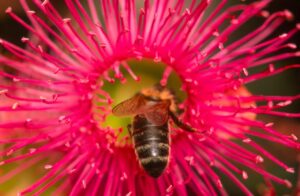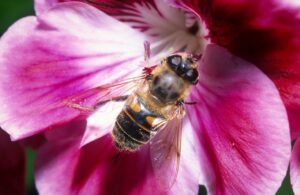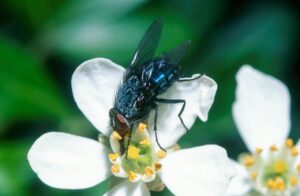
Flies as pollinators
By Denis Crawford
With European honeybee populations under pressure from varroa mite it is time to take another look at alternative pollinators.
The need for pollinators that are complementary to, or an alternative to, European honeybees has never been more critical. At its meeting on 19 September 2023, the National Management Group confirmed that eradication of varroa mite (Varroa destructor) is no longer feasible based on technical grounds.
In Pest Files of November 2020, I wrote that there has been quite a bit of research over the last 15 years or so investigating alternative pollinators. I outlined a scientific paper that had just been published at the time, which analysed all the research on non-bee crop pollinators conducted globally since 1950. The authors concluded that flies were the most important pollinators after bees.
The most common flies revealed in the study were from two fly families – Syrphidae and Calliphoridae. We know flies in the family Syrphidae as ‘hover flies’ which are well known pollinators in horticulture. The family Calliphoridae includes the much maligned ‘blowflies’, which are large hairy flies that feed on nectar. I guess blowflies have a bad name because their larvae (maggots) feed on carrion, and the adult flies are big buzzy hairy insects.

Breeding blowflies en masse has improved since my time with the Victorian Department of Agriculture in the late 1970s. Back then we bred them in cattle livers collected from the local abattoir – you can imagine the stench! Since then, non-meat-based artificial diets have been developed which don’t smell – apparently.
The ‘blue bottle fly’ Chrysoma megacephala, a blowfly, has been successfully mass reared in India and released into mango orchards for pollination. Currently the only blowfly to be mass reared successfully in Australia is the Australian sheep blowfly Lucilia cuprina – a major pest species responsible for fly strike in sheep. Once they have emerged, male blowflies are sterilised and released so that female flies that mate with the sterile males lay unfertile eggs. Over time this reduces the numbers of sheep blow flies.
Some mango growers in Australia have taken a DIY approach to mango pollination and have dragged roadkill carcasses into their orchards to attract blowflies. A Tasmanian farmer has been rearing his own blowflies for several years after discovering they improved his crop of high-value hybrid cauliflower seed.
The fly that is attracting the most attention currently is the cosmopolitan drone fly Eristalis tenax of the hover fly family Syrphidae. The drone fly is a stocky bee mimic about 15 mm long with a hairy thorax and a sparsely haired abdomen. Hairiness is important in potential pollinators! The hover flies we usually see in gardens darting around flowering plants are usually smaller and less hairy.

The larvae of drone flies are very different from the hover fly larvae that I usually talk about in these pages. In my articles I usually refer to predatory hover fly larvae which help control aphid infestations on plants. In contrast, drone fly larvae are commonly known as ‘rat-tailed’ maggots and they are aquatic. The ‘rat tail’ is actually a siphon through which they breathe. The larvae feed on decaying organic matter in ditches, sewage, and other bodies of water with high levels of organic matter.
Pollination by drone flies has been studied now for a couple of decades. For example, a study back in the 1990s showed how pollination by drone flies increased fruit size in greenhouse capsicum crops. Drone flies have been commercialised in Spain where they are sold as ‘Queenfly’ – “a generalist pollinator that can be used in different types of crops, for production of vegetable seeds, oilseeds, and ornamental seed crops, as well as for production of greenhouse vegetables, berries and subtropical fruits.”
A trial is currently underway in Tasmania into Eristalis tenax as part of a $6.4 million pollination project led by Hort Innovation Australia and several Australian Universities and other research groups. This December, about two million flies will be released as pollinators into commercial carrot crops. This is exciting stuff! I will report back once the success of the release has been analysed.
Drone flies have a couple of advantages over honey bees. They don’t sting, so they are easier to handle – therefore no need for bee suits and smokers. Drone flies don’t return to a hive at night. They remain in the crop, so there is no need to maintain hive boxes.
It’s important to note that the European honey bee is not going to disappear even if varroa mite spreads through all the eastern states. Commercial beekeepers have already factored in what they need to do. After an expected initial drop, bee numbers in managed hives should return to normal.
The feral bee population is another matter entirely. Numbers of feral bees are expected to drop by about 90% and remain there. Australia has an unknown number of feral honey bee colonies, especially in bushland. Many of the honey bees that visit our gardens are not from managed hives. Until now, feral European honey bees have provided a ‘free’ pollination service for gardeners and some commercial crops. Surely that means the value of properly managed hives goes up, as does the value of pollination services.
Main image: Free pollination by feral bees may decline (Image supplied by Denis Crawford)
